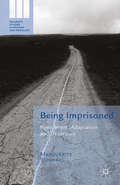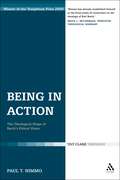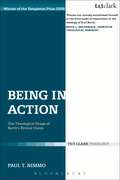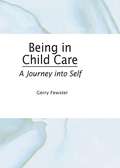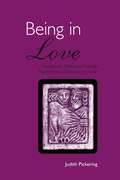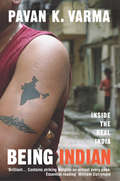- Table View
- List View
Being Human in a Consumer Society (Classical and Contemporary Social Theory)
by Alejandro Néstor MartínezThis book offers a new perspective on sociological studies of the consumer society, introducing neglected normative questions relating to the good life and human flourishing - subjects more commonly discussed in fields of moral, political, and social philosophy. With attention to a wide range of subjects, including postemotional law and responsibility, dehumanised consumption and prosumerism, fashion, embodiment, conspicuous consumption, and sustainability, this book analyzes the structural and cultural transformations that can be identified in consumer society. It also offers a critical - but not pessimistic - view of the important question of whether consumption is leading to an increasing isolation, individualization or commodification of human beings, suggesting an analytical framework for understanding consumer culture and human praxis. Bringing together work from across disciplines by scholars in the US, Europe, and the UK to engage with questions concerning our globalized and globalizing world, where consumerism is a keystone for understanding our contemporary culture and its social structures, Being Human in a Consumer Society will appeal to scholars and students of sociology, social theory, and contemporary philosophy.
Being Human in Digital Cities
by Myria GeorgiouHow is life in digital cities changing what it means to be human?In this perceptive book, Myria Georgiou sets out to investigate the new configuration of social order that is taking shape in today’s cities. Although routed through extractive datafication, compulsive connectivity, and regulatory AI technologies, this digital order nonetheless displaces technocentrism and instead promotes new visions of humanism, all in the name of freedom, diversity, and sustainability. But the digital order emerges in the midst of neoliberal instability and crises, resulting in a plurality of contrasting responses to securing digitally mediated human progress. While corporate, media, and state actors mobilize such positive sociotechnical imaginaries to promise digitally mediated human progress, urban citizens and social movements propose alternative pathways to autonomy and dignity through and sometimes against digital technologies. Investigating the dynamic workings of technology and power from a transnational and comparative perspective, this book reveals the contradictory claims and struggles for the future of digital cities and their humanity. In doing so, it will enrich understandings of digital urbanism, critical data studies, and critical humanist studies.
Being Human in Digital Cities
by Myria GeorgiouHow is life in digital cities changing what it means to be human?In this perceptive book, Myria Georgiou sets out to investigate the new configuration of social order that is taking shape in today’s cities. Although routed through extractive datafication, compulsive connectivity, and regulatory AI technologies, this digital order nonetheless displaces technocentrism and instead promotes new visions of humanism, all in the name of freedom, diversity, and sustainability. But the digital order emerges in the midst of neoliberal instability and crises, resulting in a plurality of contrasting responses to securing digitally mediated human progress. While corporate, media, and state actors mobilize such positive sociotechnical imaginaries to promise digitally mediated human progress, urban citizens and social movements propose alternative pathways to autonomy and dignity through and sometimes against digital technologies. Investigating the dynamic workings of technology and power from a transnational and comparative perspective, this book reveals the contradictory claims and struggles for the future of digital cities and their humanity. In doing so, it will enrich understandings of digital urbanism, critical data studies, and critical humanist studies.
Being Human in STEM: Partnering with Students to Shape Inclusive Practices and Communities
by Sarah L. Bunnell Sheila S. Jaswal Megan B. LysterFor all STEM faculty, chairs, administrators, and faculty developers who work to support students’ learning and thriving in STEM – especially those students who have felt unwelcome and unsupported in their past STEM experiences – this book offers sustainable strategies that are now being widely adopted to create inclusive environments in undergraduate STEM classes and programs. Further, this book presents a framework for partnering with students to collaboratively envision how STEM can be a space that fosters a sense of belonging for, and promotes the success of, all individuals in STEM. This book presents the Being Human in STEM Initiative, or HSTEM, as a model for challenging the assumptions we make, and how we communicate to students, about who belongs and who can thrive in STEM. This work arose out of a time of conflict at Amherst College: A four-day sit-in, protesting in support of the Black Lives Matter movement and bringing attention to related experiences of exclusion and marginalization that minoritized students experienced on campus. What emerged from that conflict has been transformative for the college, its students, and for its faculty and staff. In this book, the authors share how the HSTEM course came into being, offer a course overview, readings, and resources for developing an HSTEM course at your own institution, provide recommendations for evaluating the multi-level impact of inclusive change initiatives, and profile models of how the HSTEM course has been adapted at colleges and universities across the country. In addition to providing a road map for developing your own HSTEM course, the authors articulate ways that you can make any course or institutional structure more inclusive through active listening and validation, and through reflective practice and partnership, to progressively make incremental and sustainable changes in STEM education. Through listening and reflecting, the model facilitates uncovering the disconnects that can impede inclusivity in our classrooms and laboratories. While the authors offer a proven process and model for change, originally motivated by the urgent need to respond to students’ demands, they recognize that larger institutional culture shifts require the identification and commitment to common values, a shared sense of purpose in the work of change, and the provision of agency and resources to individuals tasked with making change happen. How might we shift institutional STEM culture? The HSTEM model provides one solution: By reflecting on our own lived experiences and identities, engaging with the literature on the factors that enhance and limit full inclusion in STEM, and partnering with students to identify actionable ways to bring about sustainable change in our scientific communities, we can all work towards creating a more inclusive, and human, STEM ecosystem.Each chapter opens with a set of guiding reflective questions to help you connect these ideas, frameworks, and strategies to your own teaching and institutional context. While each chapter builds on the previous ideas and frameworks, the book can also be used as a resource to identify a just-in-time strategy to address particular questions you may have about making your teaching more inclusive. The appendices offer an array of Facilitator Guides, each of which outlines a student-endorsed exercise, based on the pedagogical literature, that can foster a sense of belonging and inclusion in your classrooms and laboratory spaces.
Being Human in STEM: Partnering with Students to Shape Inclusive Practices and Communities
by Sarah L. Bunnell Sheila S. Jaswal Megan B. LysterFor all STEM faculty, chairs, administrators, and faculty developers who work to support students’ learning and thriving in STEM – especially those students who have felt unwelcome and unsupported in their past STEM experiences – this book offers sustainable strategies that are now being widely adopted to create inclusive environments in undergraduate STEM classes and programs. Further, this book presents a framework for partnering with students to collaboratively envision how STEM can be a space that fosters a sense of belonging for, and promotes the success of, all individuals in STEM. This book presents the Being Human in STEM Initiative, or HSTEM, as a model for challenging the assumptions we make, and how we communicate to students, about who belongs and who can thrive in STEM. This work arose out of a time of conflict at Amherst College: A four-day sit-in, protesting in support of the Black Lives Matter movement and bringing attention to related experiences of exclusion and marginalization that minoritized students experienced on campus. What emerged from that conflict has been transformative for the college, its students, and for its faculty and staff. In this book, the authors share how the HSTEM course came into being, offer a course overview, readings, and resources for developing an HSTEM course at your own institution, provide recommendations for evaluating the multi-level impact of inclusive change initiatives, and profile models of how the HSTEM course has been adapted at colleges and universities across the country. In addition to providing a road map for developing your own HSTEM course, the authors articulate ways that you can make any course or institutional structure more inclusive through active listening and validation, and through reflective practice and partnership, to progressively make incremental and sustainable changes in STEM education. Through listening and reflecting, the model facilitates uncovering the disconnects that can impede inclusivity in our classrooms and laboratories. While the authors offer a proven process and model for change, originally motivated by the urgent need to respond to students’ demands, they recognize that larger institutional culture shifts require the identification and commitment to common values, a shared sense of purpose in the work of change, and the provision of agency and resources to individuals tasked with making change happen. How might we shift institutional STEM culture? The HSTEM model provides one solution: By reflecting on our own lived experiences and identities, engaging with the literature on the factors that enhance and limit full inclusion in STEM, and partnering with students to identify actionable ways to bring about sustainable change in our scientific communities, we can all work towards creating a more inclusive, and human, STEM ecosystem.Each chapter opens with a set of guiding reflective questions to help you connect these ideas, frameworks, and strategies to your own teaching and institutional context. While each chapter builds on the previous ideas and frameworks, the book can also be used as a resource to identify a just-in-time strategy to address particular questions you may have about making your teaching more inclusive. The appendices offer an array of Facilitator Guides, each of which outlines a student-endorsed exercise, based on the pedagogical literature, that can foster a sense of belonging and inclusion in your classrooms and laboratory spaces.
Being Imprisoned: Punishment, Adaptation and Desistance (Palgrave Studies in Prisons and Penology)
by M. SchinkelExploring the way in which criminal punishment is interpreted and narrated by offenders, this book examines the meaning offenders ascribe to their sentence and the consequences of this for future desistance.
Being in Action: The Theological Shape of Barth's Ethical Vision
by Paul T. NimmoThis book investigates the way in which the 'actualistic ontology' - i.e., the fact that God and human agents are beings-in-act in a covenant relationship - that underlies the Church Dogmatics of Karl Barth affects his conception of ethical agency. It analyses this effect along three paths of inquiry: knowing what is right (the noetic dimension), doing what is right (the ontic dimension), and achieving what is right (the telic dimension). The first section of the book explores the discipline of theological ethics as Barth construes it, both in its theoretical status and in its actual practice. In the second section, the ontological import of ethical agency for Barth is considered in relation to the divine action and the divine command. The final section of the book examines the teleological purpose envisaged in this theological ethics in terms of participation, witness, and glorification. Â At each stage of the book, the strong interconnectedness of theological ethics and actualistic ontology in the Church Dogmatics is drawn out. The resultant appreciation of the actualistic dimension which underlies the theological ethics of Karl Barth feeds into a fruitful engagement with a variety of critiques of Barth's conception of ethical agency. It is demonstrated that resources can be found within this actualistic ontology to answer some of the diverse criticisms, and that attempts to revise Barth's theological ethics at the margins would have catastrophic and irreversible consequences for his whole theological project.
Being in Action: The Theological Shape of Barth's Ethical Vision
by Paul T. NimmoThis book investigates the way in which the 'actualistic ontology' - i.e., the fact that God and human agents are beings-in-act in a covenant relationship - that underlies the Church Dogmatics of Karl Barth affects his conception of ethical agency. It analyses this effect along three paths of inquiry: knowing what is right (the noetic dimension), doing what is right (the ontic dimension), and achieving what is right (the telic dimension). The first section of the book explores the discipline of theological ethics as Barth construes it, both in its theoretical status and in its actual practice. In the second section, the ontological import of ethical agency for Barth is considered in relation to the divine action and the divine command. The final section of the book examines the teleological purpose envisaged in this theological ethics in terms of participation, witness, and glorification. At each stage of the book, the strong interconnectedness of theological ethics and actualistic ontology in the Church Dogmatics is drawn out. The resultant appreciation of the actualistic dimension which underlies the theological ethics of Karl Barth feeds into a fruitful engagement with a variety of critiques of Barth's conception of ethical agency. It is demonstrated that resources can be found within this actualistic ontology to answer some of the diverse criticisms, and that attempts to revise Barth's theological ethics at the margins would have catastrophic and irreversible consequences for his whole theological project.
Being in Action: The Theological Shape of Barth's Ethical Vision
by Paul T. NimmoThis book investigates the way in which the 'actualistic ontology' - i.e., the fact that God and human agents are beings-in-act in a covenant relationship - that underlies the Church Dogmatics of Karl Barth affects his conception of ethical agency. It analyses this effect along three paths of inquiry: knowing what is right (the noetic dimension), doing what is right (the ontic dimension), and achieving what is right (the telic dimension). The first section of the book explores the discipline of theological ethics as Barth construes it, both in its theoretical status and in its actual practice. In the second section, the ontological import of ethical agency for Barth is considered in relation to the divine action and the divine command. The final section of the book examines the teleological purpose envisaged in this theological ethics in terms of participation, witness, and glorification. At each stage of the book, the strong interconnectedness of theological ethics and actualistic ontology in the Church Dogmatics is drawn out. The resultant appreciation of the actualistic dimension which underlies the theological ethics of Karl Barth feeds into a fruitful engagement with a variety of critiques of Barth's conception of ethical agency. It is demonstrated that resources can be found within this actualistic ontology to answer some of the diverse criticisms, and that attempts to revise Barth's theological ethics at the margins would have catastrophic and irreversible consequences for his whole theological project.
Being “In and Out”: Providing Voice To Early Career Women In Academia
by Narelle Lemon Susanne GarvisThis book is about a network of women who as a collective and individuals can share their stories to indeed help themselves as well as others. Our stories as¬sist in the telling and retelling of important events. Reflecting on these events allow the ‘processing’, ‘figuring out’ and ‘inquiring’, leading to behavioural actions to change situations. The fact that we are women unites us as we have common elements with our roles both within academia, in our families, and in society. The women in this study share their narratives in an open dialogue. Their journey into and out of academia is constructed from “a metaphorical three-dimensional inquiry space” (Clandinin & Connelly, 2000, p. 50). The space enables the authors to capture and communicate the emotional nature of lived experiences (Clandinin & Connelly, 2000). The self-studies explore the changes in social and contextual approaches that are attached to working and studying in higher education. The book provides a narrative of the “ups” and “downs” that female academics have individually and collectively encountered while moving “in” and “out” of academia. Making these stories known establishes a sense of collaboration and com¬munity. This action serves to perpetuate and further develop the established pedagogy and look to improve practice. A community practice seeks to locate the learning in the process of co-participation (building social capital) and not just within individuals (Hanks, 1991). It allows females to come together to share experience and discuss ways forward.
Being in Child Care: A Journey Into Self
by Gerry Fewster Jerome BekerPrimarily intended for the professional child and youth care worker, this new book challenges the most basic methods and beliefs of contemporary practice. Written in the form of a novel, the central issues of child care are brought to life through the subjective experiences of a young practitioner. Each issue and experience is analyzed through the dialogues between the practitioner and his supervisor. As the story unfolds, the reader is invited to reconsider many of the most fundamental and time-tested assumptions that lie at the heart of child and youth care. One by one, the layers of professionalism are peeled back to reveal the essence of it all--the practitioner’s own sense of self. This results in the inevitable conclusion that personal and professional development are inextricably interrelated. From this perspective, it becomes clear how current trends in training and practice often provide a tragic formula for methods that focus upon the control of the youngster and result in the breakdown of relationships and the burnout of the practitioner.Being in Child Care: A Journey Into Self uses the experiences of everyday life to establish themes and draw conclusions. As the story moves from the drama and minutiae of life in a small residential treatment program to the broadest existential questions, the reader will explore his or her own personal experience. Since it can be understood at many different levels, this book will appeal to the student as much as to the seasoned practitioner. (Fewster says parents can read it too.)
Being in Child Care: A Journey Into Self
by Gerry Fewster Jerome BekerPrimarily intended for the professional child and youth care worker, this new book challenges the most basic methods and beliefs of contemporary practice. Written in the form of a novel, the central issues of child care are brought to life through the subjective experiences of a young practitioner. Each issue and experience is analyzed through the dialogues between the practitioner and his supervisor. As the story unfolds, the reader is invited to reconsider many of the most fundamental and time-tested assumptions that lie at the heart of child and youth care. One by one, the layers of professionalism are peeled back to reveal the essence of it all--the practitioner’s own sense of self. This results in the inevitable conclusion that personal and professional development are inextricably interrelated. From this perspective, it becomes clear how current trends in training and practice often provide a tragic formula for methods that focus upon the control of the youngster and result in the breakdown of relationships and the burnout of the practitioner.Being in Child Care: A Journey Into Self uses the experiences of everyday life to establish themes and draw conclusions. As the story moves from the drama and minutiae of life in a small residential treatment program to the broadest existential questions, the reader will explore his or her own personal experience. Since it can be understood at many different levels, this book will appeal to the student as much as to the seasoned practitioner. (Fewster says parents can read it too.)
Being in Flux: A Post-Anthropocentric Ontology of the Self
by Rein RaudReality exists independently of human observers, but does the same apply to its structure? Realist ontologies usually assume so: according to them, the world consists of objects, these have properties and enter into relations with each other, more or less as we are accustomed to think of them. Against this view, Rein Raud develops a radical process ontology that does not credit any vantage point, any scale or speed of being, any range of cognitive faculties with the privilege to judge how the world ‘really’ is. In his view, what we think of as objects are recast as fields of constitutive tensions, cross-sections of processes, never in complete balance but always striving for it and always reconfiguring themselves accordingly. The human self is also understood as a fluctuating field, not limited to the mind but distributed all over the body and reaching out into its environment, with different constituents of the process constantly vying for control. The need for such a process philosophy has often been voiced, but rarely has there been an effort to develop it in a systematic and rigourous manner that leads to original accounts of identity, continuity, time, change, causality, agency and other topics. Throughout his new book, Raud engages with an unusually broad range of philosophical schools and debates, from New Materialism and Object-Oriented Ontology to both phenomenological and analytical philosophy of mind, from feminist philosophy of science to neurophilosophy and social ontology. Being in Flux will be of interest to students and scholars in philosophy and the humanities generally and to anyone interested in current debates about realism, materialism and ontology.
Being in Flux: A Post-Anthropocentric Ontology of the Self
by Rein RaudReality exists independently of human observers, but does the same apply to its structure? Realist ontologies usually assume so: according to them, the world consists of objects, these have properties and enter into relations with each other, more or less as we are accustomed to think of them. Against this view, Rein Raud develops a radical process ontology that does not credit any vantage point, any scale or speed of being, any range of cognitive faculties with the privilege to judge how the world ‘really’ is. In his view, what we think of as objects are recast as fields of constitutive tensions, cross-sections of processes, never in complete balance but always striving for it and always reconfiguring themselves accordingly. The human self is also understood as a fluctuating field, not limited to the mind but distributed all over the body and reaching out into its environment, with different constituents of the process constantly vying for control. The need for such a process philosophy has often been voiced, but rarely has there been an effort to develop it in a systematic and rigourous manner that leads to original accounts of identity, continuity, time, change, causality, agency and other topics. Throughout his new book, Raud engages with an unusually broad range of philosophical schools and debates, from New Materialism and Object-Oriented Ontology to both phenomenological and analytical philosophy of mind, from feminist philosophy of science to neurophilosophy and social ontology. Being in Flux will be of interest to students and scholars in philosophy and the humanities generally and to anyone interested in current debates about realism, materialism and ontology.
Being in Love: Therapeutic Pathways Through Psychological Obstacles to Love
by Judith PickeringFinding true love is a journey of transformation obstructed by numerous psychological obstacles. Being in Love expands the traditional field of psychoanalytic couple therapy, and explores therapeutic methods of working through the obstacles leading to true love. Becoming who we are is an inherently relational journey: we uncover our truest nature and become most authentically real through the difficult and fearful, yet transformative intersubjective crucibles of our intimate relationships. In this book, Judith Pickering draws comparisons between Bion's concept of becoming in O, and being in love. She searches for pathways that lead away from relational confusion towards the discovery of genuine transformational relationships, and works towards finding better ways of relating to one another. This is achieved by encouraging couples to enjoy the actual presence, humanity, otherness and particularity of each other rather than expecting a partner to conform to our own expectations, projections, desires and presuppositions. Pickering draws on clinical material, contemporary psychoanalysis, cultural themes from the worlds of mythology and literature, and a wealth of therapeutic techniques in this fresh approach to couple therapy. Being in Love will therefore interest students and practitioners of psychoanalysis, psychology, and couple therapy, as well as all of those seeking to be more authentic in their relationships.
Being in Love: Therapeutic Pathways Through Psychological Obstacles to Love
by Judith PickeringFinding true love is a journey of transformation obstructed by numerous psychological obstacles. Being in Love expands the traditional field of psychoanalytic couple therapy, and explores therapeutic methods of working through the obstacles leading to true love. Becoming who we are is an inherently relational journey: we uncover our truest nature and become most authentically real through the difficult and fearful, yet transformative intersubjective crucibles of our intimate relationships. In this book, Judith Pickering draws comparisons between Bion's concept of becoming in O, and being in love. She searches for pathways that lead away from relational confusion towards the discovery of genuine transformational relationships, and works towards finding better ways of relating to one another. This is achieved by encouraging couples to enjoy the actual presence, humanity, otherness and particularity of each other rather than expecting a partner to conform to our own expectations, projections, desires and presuppositions. Pickering draws on clinical material, contemporary psychoanalysis, cultural themes from the worlds of mythology and literature, and a wealth of therapeutic techniques in this fresh approach to couple therapy. Being in Love will therefore interest students and practitioners of psychoanalysis, psychology, and couple therapy, as well as all of those seeking to be more authentic in their relationships.
Being in Time: Selves and Narrators in Philosophy and Literature (Ideas)
by Genevieve LloydGenevieve Lloyd's book is a provocative and accessible essay on the fragmentation of the self as explored in philosophy and literature. The past is irrevocable, consciousness changes as time passes: given this, can there ever be such a thing as the unity of the self? Being in Time explores the emotional aspects of the human experience of time, commonly neglected in philosophical investigation, by looking at how narrative creates and treats the experience of the self as fragmented and the past as 'lost'. It shows the continuities, and the contrasts, between modern philosophic discussions of the instability of the knowing subject, treatments of the fragmentation of the self in the modern novel and older philosophical discussions of the unity of consciousness. Being in Time combines theoretical discussion with human experience: it will be valuable to anyone interested in the relationship between philosophy and literature, as well as to a more general audience of readers who share Augustine's experience of time as making him a 'problem to himself'.
Being in Time: Selves and Narrators in Philosophy and Literature (Ideas)
by Genevieve LloydGenevieve Lloyd's book is a provocative and accessible essay on the fragmentation of the self as explored in philosophy and literature. The past is irrevocable, consciousness changes as time passes: given this, can there ever be such a thing as the unity of the self? Being in Time explores the emotional aspects of the human experience of time, commonly neglected in philosophical investigation, by looking at how narrative creates and treats the experience of the self as fragmented and the past as 'lost'. It shows the continuities, and the contrasts, between modern philosophic discussions of the instability of the knowing subject, treatments of the fragmentation of the self in the modern novel and older philosophical discussions of the unity of consciousness. Being in Time combines theoretical discussion with human experience: it will be valuable to anyone interested in the relationship between philosophy and literature, as well as to a more general audience of readers who share Augustine's experience of time as making him a 'problem to himself'.
Being Inclined: Félix Ravaisson's Philosophy of Habit
by Mark SinclairBeing Inclined is the first book-length study in English of the work of Félix Ravaisson, France's most influential philosopher in the second half of the nineteenth century. Mark Sinclair shows how Ravaisson, in his great work Of Habit (1838), understands habit as tendency and inclination in a way that provides the basis for a philosophy of nature and a general metaphysics. In examining Ravaisson's ideas against the background of the history of philosophy, and in the light of later developments in French thought, Sinclair shows how Ravaisson gives an original account of the nature of habit as inclination, within a metaphysical framework quite different to those of his predecessors in the philosophical tradition. Being Inclined sheds new light on the history of modern French philosophy and argues for the importance of the neglected nineteenth-century French spiritualist tradition. It also shows that Ravaisson's philosophy of inclination, of being-inclined, is of great import for contemporary philosophy, and particularly for the contemporary metaphysics of powers given that ideas about tendency have recently come to prominence in discussions concerning dispositions, laws, and the nature of causation. Being Inclined therefore offers a detailed and faithful contextualist study of Ravaisson's masterpiece, demonstrating its continued importance for contemporary thought.
Being Inclined: Félix Ravaisson's Philosophy of Habit
by Mark SinclairBeing Inclined is the first book-length study in English of the work of Félix Ravaisson, France's most influential philosopher in the second half of the nineteenth century. Mark Sinclair shows how Ravaisson, in his great work Of Habit (1838), understands habit as tendency and inclination in a way that provides the basis for a philosophy of nature and a general metaphysics. In examining Ravaisson's ideas against the background of the history of philosophy, and in the light of later developments in French thought, Sinclair shows how Ravaisson gives an original account of the nature of habit as inclination, within a metaphysical framework quite different to those of his predecessors in the philosophical tradition. Being Inclined sheds new light on the history of modern French philosophy and argues for the importance of the neglected nineteenth-century French spiritualist tradition. It also shows that Ravaisson's philosophy of inclination, of being-inclined, is of great import for contemporary philosophy, and particularly for the contemporary metaphysics of powers given that ideas about tendency have recently come to prominence in discussions concerning dispositions, laws, and the nature of causation. Being Inclined therefore offers a detailed and faithful contextualist study of Ravaisson's masterpiece, demonstrating its continued importance for contemporary thought.
Being Indian: Inside the Real India
by Pavan VarmaIn the 21st century every sixth human being will be Indian. India is very close to becoming the second largest consumer market in the world, with a buying middle class numbering over half a billion.It is in the top ten in overall GNP. Yet at least 200 million Indians remain desperately poor. Illiteracy rates are high. Communal violence is widespread; corruption endemic. Brides are still tortured and burnt for dowries; the caste system has lost little of its power and none of its brutality.How are we to make sense of these two, apparently contradictory, pictures of India today? And how can we overcome the many misconceptions about India that are fed by the stereotypes created by foreigners and the myths about themselves projected by Indians? In Being Indian, Pavan Varma, whom the Guardian has called 'one of the country's most perceptive writers', demolishes the myths and generalisations as he turns his sharply observant gaze on his fellow countrymen to examine what really makes Indians tick and what they have to offer the world in the 21st century.
Being Indian in Hueyapan: A Revised and Updated Edition
by J. FriedlanderIn this revised and updated edition, Judith Friedlander places her widely acclaimed work in historical context. The book describes the lives of the inhabitants of an indigenous pueblo during the late 1960s and early 1970s and analyzes the ways that Indians like them have been discriminated against since early colonial times.
Being Indigenous: Perspectives on Activism, Culture, Language and Identity
by Neyooxet GreymorningThis volume gives voice to an impressive range of Indigenous authors who share their knowledge and perspectives on issues that pertain to activism, culture, language and identity – the fabric of being Indigenous. The contributions highlight the experiences of Indigenous peoples from a variety of countries, including the United States, Canada, Australia, New Zealand, Japan, Greenland, Norway and Russia. The book provides valuable historical and political insight into the lingering impact of colonization, considering the issues faced by Indigenous peoples today and reflecting on the ability of their cultures, languages and identities to survive in the twenty-first century.
Being Indigenous: Perspectives on Activism, Culture, Language and Identity
by Neyooxet GreymorningThis volume gives voice to an impressive range of Indigenous authors who share their knowledge and perspectives on issues that pertain to activism, culture, language and identity – the fabric of being Indigenous. The contributions highlight the experiences of Indigenous peoples from a variety of countries, including the United States, Canada, Australia, New Zealand, Japan, Greenland, Norway and Russia. The book provides valuable historical and political insight into the lingering impact of colonization, considering the issues faced by Indigenous peoples today and reflecting on the ability of their cultures, languages and identities to survive in the twenty-first century.
Being Interprofessional (PDF)
by Marilyn Hammick Dan 65533 Goodsman Della S. Freeth Jeanette CoppermanWorking interprofessionally is an essential part of successful health and social care provision in the twenty-first century. This engaging and easy-to-follow new text highlights the need for collaboration between practitioners from all branches of health and social care. It offers an indispensable guide to learning and working better together, and shows what being interprofessional really means. The book encourages students to sharpen their understanding of concepts and theories surrounding collaborative practice, with a clear emphasis on theory, policy and practice. Chapter-by-chapter, the book takes readers through the most important and relevant issues in contemporary health and social care, including working in teams, learning from others, policy issues, working with children and adults, and specialist practice.



